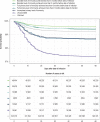Vaccine-Induced or Hybrid Immunity and COVID-19-Associated Mortality During the Omicron Wave
- PMID: 37013438
- PMCID: PMC10277809
- DOI: 10.3238/arztebl.m2023.0051
Vaccine-Induced or Hybrid Immunity and COVID-19-Associated Mortality During the Omicron Wave
Abstract
Background: It is not yet entirely clear to what extent vaccine-induced or hybrid immunity offers protection from death during the omicron wave of the COVID-19 pandemic in Germany.
Methods: In this retrospective study, we evaluated 470 159 cases aged ≥ 60 years in the German federal state of Bavaria who tested positive for SARS-CoV-2 between 1 January and 30 June 2022. Cox models were used to estimate adjusted hazard ratios (aHR) for dying within 60 days of the infection, depending on sex, age, time of infection, and different levels of immunity.
Results: Over the period of observation, 3836 COVID-19-associated deaths were registered (case fatality rate 0.82%). The risk of death was significantly lower in cases with a higher level of immunity than in unvaccinated cases (aHR for a full primary level of immunity if reached less than 6 months before the date of the infection: 0.30, 95% confidence interval [0.23; 0.39]; if reached more than 6 months before: aHR 0.46 [0.35; 0.60]). A boosted level of immunity lowered the risk of death even further (if reached less than 3 months before the infection: aHR 0.17 [0.15; 0.20]; if reached more than 3 months before: aHR 0.25 [0.21; 0.29]).
Conclusion: Among elderly persons in Bavaria, a higher immunity level was associated with a substantial degree of protection against death during the Omicron wave; however, the strength of protection may have diminished somewhat over time.
Figures








References
-
- Lange B, Jäger VK, Rückeret V, et al. 2 Interimsanalyse des IMMUNEBRIDGE Projektes zur Kommunikation von vorläufigen Ergebnissen an das Modellierungsnetz für schwere Infektionskrankheiten 2022. www.bmbf.de/SharedDocs/Downloads/de/2022/20221013-zwischenbericht-immunb... (last accessed on 4 January 2023)
-
- Robert Koch Institut. COVID-19-Dashboard. https://experience.arcgis.com/experience/478220a4c454480e823b17327b2bf1d... (last accessed on 4 October 2022)
MeSH terms
LinkOut - more resources
Full Text Sources
Medical
Miscellaneous

